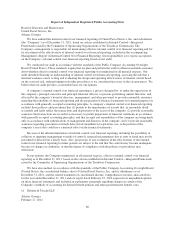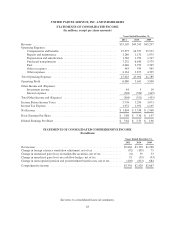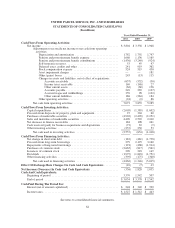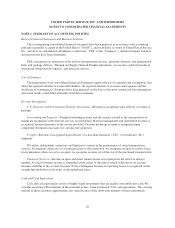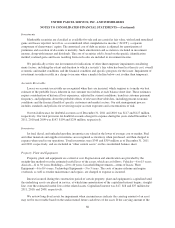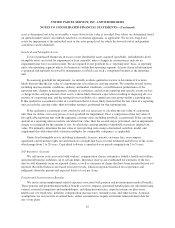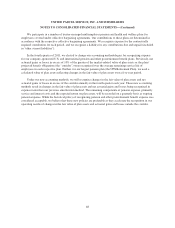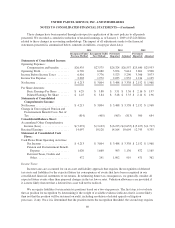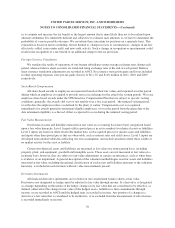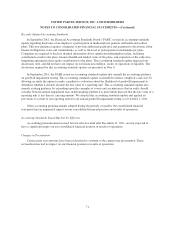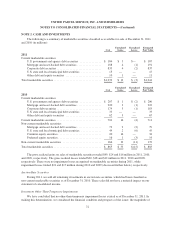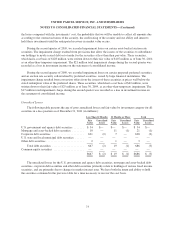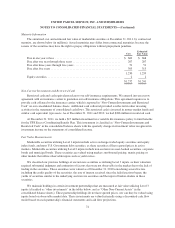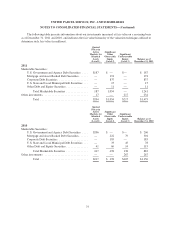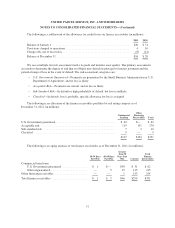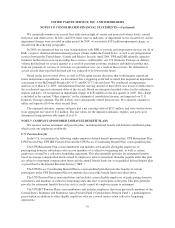UPS 2011 Annual Report Download - page 81
Download and view the complete annual report
Please find page 81 of the 2011 UPS annual report below. You can navigate through the pages in the report by either clicking on the pages listed below, or by using the keyword search tool below to find specific information within the annual report.
UNITED PARCEL SERVICE, INC. AND SUBSIDIARIES
NOTES TO CONSOLIDATED FINANCIAL STATEMENTS—(Continued)
These changes have been reported through retrospective application of the new policies to all periods
presented. We recorded a cumulative reduction of retained earnings as of January 1, 2009 of $3.226 billion
related to these changes in accounting methodology. The impact of all adjustments made to the financial
statements presented is summarized below (amounts in millions, except per share data):
2011 2010 2009
Recognized Under
Previous Method
Recognized Under
New Method
Previously
Reported Adjusted
Previously
Reported Adjusted
Statements of Consolidated Income:
Operating Expenses:
Compensation and benefits ...... $26,935 $27,575 $26,324 $26,557 $25,640 $25,933
Operating Profit ................... 6,720 6,080 5,874 5,641 3,801 3,508
Income Before Income Taxes ........ 6,416 5,776 5,523 5,290 3,366 3,073
Income Tax Expense ............... 2,203 1,972 2,035 1,952 1,214 1,105
Net Income ....................... $ 4,213 $ 3,804 $ 3,488 $ 3,338 $ 2,152 $ 1,968
Per Share Amounts:
Basic Earnings Per Share ........ $ 4.29 $ 3.88 $ 3.51 $ 3.36 $ 2.16 $ 1.97
Diluted Earnings Per Share ...... $ 4.25 $ 3.84 $ 3.48 $ 3.33 $ 2.14 $ 1.96
Statements of Consolidated
Comprehensive Income:
Net Income ....................... $ 4,213 $ 3,804 $ 3,488 $ 3,338 $ 2,152 $ 1,968
Change in Unrecognized Pension and
Postretirement Benefit Costs, Net of
Tax ........................... (814) (405) (963) (813) 500 684
Consolidated Balance Sheet:
Accumulated Other Comprehensive
Income (Loss) ................... $(7,072) $ (3,103) $ (6,195) $ (2,635) $ (5,127) $ (1,717)
Retained Earnings ................. 14,097 10,128 14,164 10,604 12,745 9,335
Statement of Consolidated Cash
Flows:
Cash Flows From Operating Activities:
Net Income ................... $ 4,213 $ 3,804 $ 3,488 $ 3,338 $ 2,152 $ 1,968
Pension and Postretirement Benefit
Expense ................... 1,020 1,660 903 1,136 872 1,165
Deferred Taxes, Credits and
Other ...................... 472 241 1,002 919 471 362
Income Taxes
Income taxes are accounted for on an asset and liability approach that requires the recognition of deferred
tax assets and liabilities for the expected future tax consequences of events that have been recognized in our
consolidated financial statements or tax returns. In estimating future tax consequences, we generally consider all
expected future events other than proposed changes in the tax law or rates. Valuation allowances are provided if
it is more likely than not that a deferred tax asset will not be realized.
We recognize liabilities for uncertain tax positions based on a two-step process. The first step is to evaluate
the tax position for recognition by determining if the weight of available evidence indicates that it is more likely
than not that the position will be sustained on audit, including resolution of related appeals or litigation
processes, if any. Once it is determined that the position meets the recognition threshold, the second step requires
69



